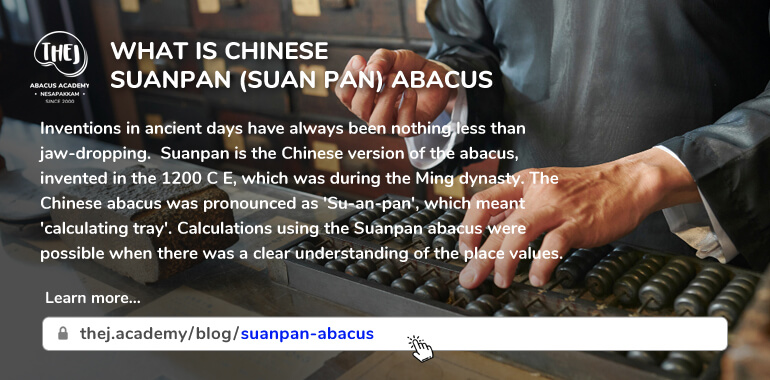Introduction
History always has its way of fascinating the present-day generations. To begin with, inventions in ancient days have always been nothing less than jaw-dropping. Moreover, starting from numbers to calculations, inventions related to arithmetics have been quite creative and indigenous.
Speaking of which, let us discuss the invention and history of the Chinese Suanpan abacus. As fascinating as it sounds, history clearly remembers it as one of the most remarkable inventions in Mathematics.
Thej academy has been educating you with the history of each abacus every month. Moreover, we are back with another interesting article. So, grab a seat. Let’s talk in detail about the Chinese Suanpan abacus.

Table of Contents
- History of the Chinese Suanpan Abacus
- Counting in the Suanpan Abacus
- Roman and Chinese Abacus – the Coincidence
- Addition Using Suanpan Abacus
- Multiplication using Suanpan abacus
- Division using the Chinese Suanpan abacus
- How do the Japanese and Chinese abacus differ?
- Suanpan in modern age
- The Chinese honoring their tradition
- The symbol of Chinese identity
- Conclusion
History of the Chinese Suanpan Abacus
Suanpan is the Chinese version of the abacus, invented in the 1200 C E, which was during the Ming dynasty. It was an influenced version of the earlier versions, hence the inventor’s credits go to the ancient Chinese in general. In 206 BC- 220 AD, prototypes of the Suanpan abacus were designed. It happened during the Han dynasty.
The design of the Suanpan abacus was simple. The device had a wooden frame with metal reinforcements. It had two decks and a separating beam in between them. The top deck had 2 beads and the bottom deck had 5 beads. Indeed, the beads on the lower deck were called the ‘Earth beads’ or ‘Water beads’. Their value was 1 per bead. In addition, the beads on the upper deck were called ‘Heaven beads’. They carried a value of 5 per bead.
The Chinese abacus was pronounced as ‘Su-an-pan’, which meant ‘calculating tray’.
Counting in the Suanpan Abacus
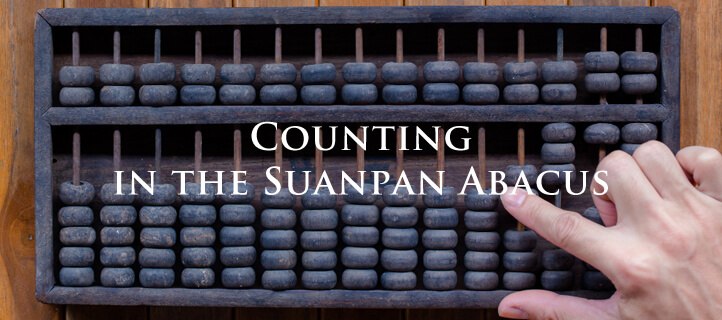
The earlier Suanpan abacus had 23 columns in it. It facilitated 2 calculations being performed at once, using one device. In addition, the place values on the Suan pan were very similar to the Indian counting system. Place values were given from the rightmost column.
Firstly, the rightmost column represents ones. Secondly, the adjacent left one represents tens, hundreds, and so on. To begin with, one had to use the heavenly bead whenever the calculation involved numbers more than 5. Ancient Chinese called using the heavenly beads as ‘Extra Bead Technique’ or ‘Suspended Bead Technique’. The Suan pan was quite famous for counting among the adults who handle business. Abacus was not just reserved for children, back in those days.
Calculations using the Suanpan abacus were possible when there was a clear understanding of the place values.
Roman and Chinese Abacus – the Coincidence
In brief, the Roman and Chinese abaci coincidentally resemble each other much. Experts believe this must be because of the trade relationship between China and Rome, that led to the influenced abacus design. While there is no logical proof to demonstrate this, it might just be a coincidence. In conclusion, even though the number of beads was similar, the Chinese abacus used wires to connect beads. In contrast, the Roman abacus used grooves.
Also, the ancient Roman abacus had a 1:4 design(1 heaven bead and 4 earth beads). Whereas the earlier Suan Pan had a 2:5 design (2 heaven beads and 5 earth beads).
Addition Using Suanpan Abacus
Before we start calculating, set the abacus to zero. Clear all the beads to their original places and away from the central beam. This is called ‘Setting Zero’ in the abacus.
Let’s try to add 23 + 7
Step 1
Firstly, know the place value 23
- 2 = Tens
- 3 = ones
Step 2
Secondly, push 3 beads from the lower deck towards the center.
Push 2 beads from the lower deck of the nearby (left) column towards the central beam.
Step 3
Now you can see 23 on the abacus
Step 4
Thirdly, let’s add the next number, which is 7.
Know the place value. Certainly, 7 belongs in ones.
Step 5
We already have 3 in the ones column. It becomes impossible to add another 7, even if we use the upper deck beads. Therefore, we take 10 from the tens column and subtract 3 from the ones column.
Push 1 bead up in the tens column. Subtract the 3 from the ones column. This means, you have made 10-3, which is equal to 7.
Step 6
Finally, read the value on the abacus. It has 3 beads in the lower deck of the tens column and zero beads in the ones column.
Clearly, the answer is 30.
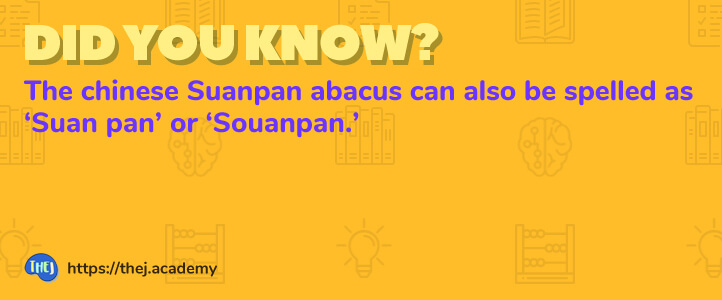
Multiplication using Suanpan abacus
Before we start calculating, set the abacus to zero. Clear all the beads to their original places and away from the central beam.
Lets multiply 56 X 48.
Step 1
Firstly, set zero
Step 2
Secondly, set 56 on the leftmost column.
Step 3
Thirdly, leave a column to avoid confusion, and set 48 in the next respective columns. Lets begin the calculation. Now, we are about to multiply each number separately to get the final result.
Step 4
Remember the steps are as follows
Multiply
- Tens with tens
- Tens with ones
- Ones with tens
- Ones with tens.
Relax, we are going to break it down to you step by step.
Place value of 56
- 5 = Tens
- 6 = Ones
Place value of 48
- 4 = Tens
- 8 = Ones
Step 5
Now follow the rule of multiplication mentioned above.
Multiply tens with tens
5 X 4 = 20
Leave aside a column and set 20.
Step 6
Multiply tens with ones
5 X 8 = 40
The tens column is already taken. So, set 40 in the next column.
Step 7
Now, multiply ones with tens
6 X 4 = 20.
The recent 10’s column is taken by 40. So, add 50 and subtract 30. (to make it 20). Add 4 in the next column.
Step 8
Now, multiply ones with tens
6 X 8 = 48
The tens column is taken by 40. Therefore, we add 50 and subtract 10 from the same column. Following that, add 8 in the next column.
Step 9
At this time, read the value of beads in the abacus.
It says 2688.
Finally, the answer 2688.
While multiplying using the Chinese abacus, you have to be extremely mindful of the place value.
Division using the Chinese Suanpan abacus
Dividing numbers using the Suan Pan abacus followed the basic steps of manipulation used commonly in all types of abacus, in the history. Also, In case of division, all the five beads on the lower deck were never pushed up. In such a case, these 5 beads are pushed down and one heaven bead is used to replace these earth beads.
Similarly, in case 2 heaven beads are pushed down, then one earth bead from the previous column is pushed up to replace those beads.
Dividing numbers using the Chinese abacus requires you to memorize a set of traditional rules which will come in handy while dividing the numbers.
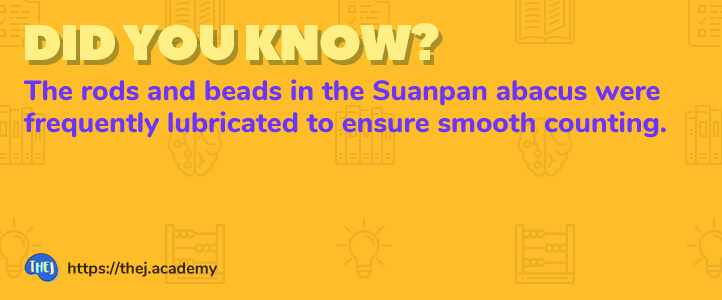
The Chinese Division table
In the below set of tables,
- plus 1 means adding 1 to the column immediately to the right,
- plus 2 means adding 2 and so on…
- forward 1 means adding 1 to the column immediately to the left.
Division tables to memorize
1/1 = forward 1
1/2 = 5
2/2 = forward 1
1/3 = 3 plus 1
2/3 = 6 plus 2
3/3 = forward 1
1/4 = 2 plus 2
2/4 = 5
3/4 = 7 plus 2
4/4 = forward 1
1/5 = 2
2/5 = 4
3/5 = 6
4/5 = 8
5/5 = forward
1/6 = 1 plus 4
2/6 = 3 plus 2
3/6 = 5
4/6 = 6 plus 4
5/6 = 8 plus 2
6/6 = forward 1
1/7 = 1 plus 3
2/7 = 2 plus 6
3/7 = 4 plus 2
4/7 = 5 plus 5
5/7 = 7 plus 1
6/7 = 8 plus 4
7/7 = forward 11/8 = 1 plus 2
2/8 = 2 plus 4
3/8 = 3 plus 6
4/8 = 5
5/8 = 6 plus 2
6/8 = 7 plus 4
7/8 = 8 plus 6
8/8 = forward 1
1/9 = 1 plus 1
2/9 = 2 plus 2
3/9 = 3 plus 3
4/9 = 4 plus 4
5/9 = 5 plus 5
6/9 = 6 plus 6
7/9 = 7 plus 7
8/9 = 8 plus 8
9/9 = forward 1
A clear understanding of this table is integral to performing divisions using the Chinese abacus. The tables look complicated at first glance, but when you take a closer look at them, they’re actually simpler.
For example,
2 /3 = 6 plus 2 ==> 20 ÷ 3 = 6 with remainder 2. Place 2 one column to the right.
7 /7 = forward 1 ==> 7 ÷ 7 = 1, place 1 one column to the left
Let’s divide 128 by 2.
Step 1
Firstly, set zero
Step 2
Secondly, set the dividend 128 on the right side of the device and the divisor 2 on the left end.
Step 3
Thirdly, compare divisor 2 with dividend 1 and follow rule: 1 /2 = 5 . Therefore, the first number in the quotient will be 5
Remove 1 and replace it with 5 leaving the remainder 28 on the abacus.
Step 4
Compare divisor 2 with 2 on dividend side and follow rule 2 /2 = forward 1. Forward 1 to quotient 5 on dividend side and subtract 2, leaving the interim answer 6 and remainder 8
Step 5
Compare divisor 2 with 8 on dividend side and follow rule 8 / 2 = forward 4 . Forward 4 and subtract 8, leaving 64 on the dividend side of the abacus
Step 6
Read the value of beads on the dividend side of the abacus.
It says 64.
Hence the answer 64.
Similarly, larger numbers can also be divided in the same way, using the Suanpan abacus.

How do the Japanese and Chinese abacus differ?
While it is debated that the Japanese(Soroban) and the Chinese (Suan pan) are an influenced versions of each other, there a quite a few remarkable differences between the both.
Name
The Japanese abacus is called as ‘Soroban abacus’, whereas the Chinese abacus is called as the ‘Suan pan’ abacus
The Design
The Suan pan has 2 decks with 2 beads on the top deck and 5 beads on the bottom deck. The Soroban abacus has 2 decks with one bead on the top deck and 4 beads in the bottom
Complexity in calculations
The Soroban abacus had reduced number of beads so calculating using this device was easier and simpler. The Suan pan on the other hand, certainly had more number of beads, leading to complexity in calculating larger numbers.
Usage
The Chinese Suan pans have completely disappeared due to the economic switch to the metric units of measure. They can only be seen in museums or in small heritage shops
As a rarely used medium of calculation. On the contrary, the Japanese Soroban abacus is being actively practiced in Japanese schools. Soroban abacus is also fund to be hanging around in the Asian region due to its design facilitating decimal calculations.
Suanpan in modern age
The traditional Suan pan abacus is being taught in schools in Hong Kong and China. Surprisingly, in few under-developed countries, the Suan pan abacus is used as the secondary mode of calculation. This also shows the efficacy, ease of use and the accuracy of the Suan pan abacus.
The early calculators were slow and could handle only 8 to 10 digits. . It is undeniable that after the advent of modern day calculators in pocket sizes, people gradually lost interest in the Chinese Suan pan abacus.But, slowly as technology advanced, people also realized that the chinese abacus could never compete with a electronic calculating device. This realization hit as arithmetics evolved into branches like integers, trigonometry, Integration, differentiation, etc.
But is is undeniable that after the advent of modern day calculators in pocket sizes, people gradually lost interest in the Chinese Suan pan abacus.
The Chinese honoring their tradition
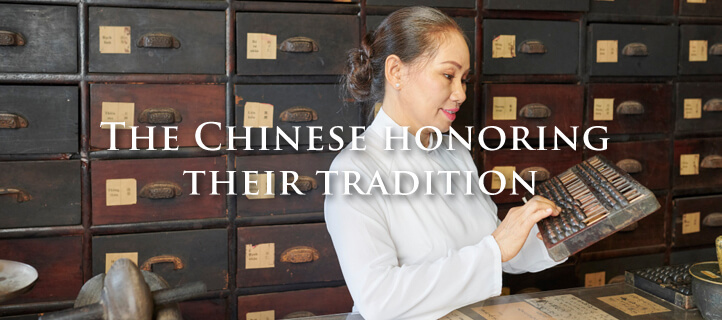
Even these days, parents send their children to tutoring classes to learn the traditional Suan pan abacus for two reasons
- To honor the tradition and to certainly pass it on to the next generation.
- For their children to learn the usage of bead arithmetic as a mode of calculation, and as a learning aid for better, faster and more accurate mental arithmetic performance.
Not gonna lie, the operational simplicity of the Suan pan has won the hearts of so many Chinese people, that it is still used by few heritage loving small shop owners in China.
The symbol of Chinese identity
Despite the faded popularity and usage, the Chinese Suan pans still stand as the symbol of traditional Chinese identity. By 2002, it was evident that abacus was actually kept aside as a kids learning activity than as a mode of major calculations. The advent of modern day technological developments does have it’s impact on anything and everything.
While it has taken away a device and a practice that is closely related to the Chinese culture, some parents make the effort to make their kids learn their traditional abacus. Being a symbol of their ancient identity of evolution, the Suan pan abacus will certainly remain a bench mark in the history of mathematical inventions.

Conclusion
Moving on, people these days are more interested in saving time, in every tedious arithmetic process. But what we do forget, is that we are becoming completely dependent on fancy, electronic devices, which will eventually make the human brain forget it’s ability to calculate complex calculations using beads and fingers. This is why exactly children these days should make an effort to learn abacus.
Let’s be honest here. Furthermore, if abacus isn’t going to help you exactly with your academic performance, you are missing out on a lot of other cognitive abilities. To begin with, focus, improved creativity, confidence, easy mental math, logical reasoning, easy visualization, imagination of elements and a strengthened memory are a few in that list.
With the fastest moving day to day life with technological innovations, let us not deprive children of training them in the abilities that their brains are capable of. Join Thej academy today to know more about our courses offered. We have a happy clientele with satisfied parents. In addition, we post informative and educational articles every month on interesting topics related to our courses. Feel free to give us a call, if you have any questions.

